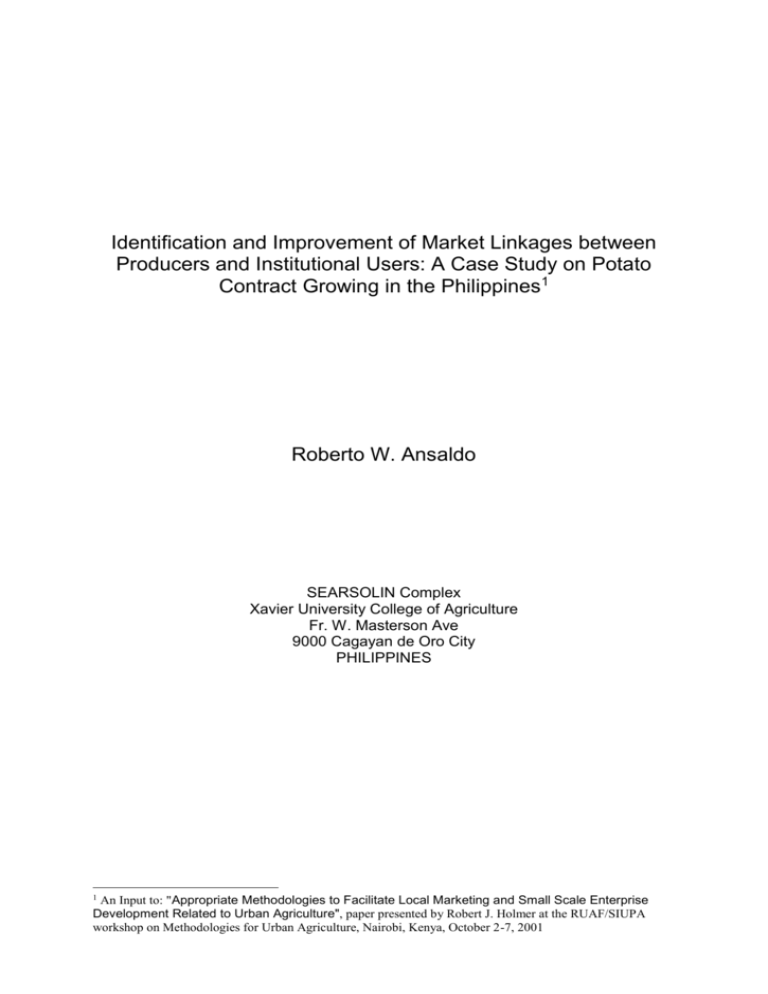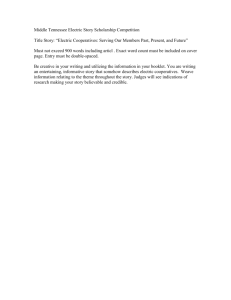A paper on: "Methodology to Identify and Improve Market Linkage
advertisement

Identification and Improvement of Market Linkages between Producers and Institutional Users: A Case Study on Potato Contract Growing in the Philippines1 Roberto W. Ansaldo SEARSOLIN Complex Xavier University College of Agriculture Fr. W. Masterson Ave 9000 Cagayan de Oro City PHILIPPINES 1 An Input to: "Appropriate Methodologies to Facilitate Local Marketing and Small Scale Enterprise Development Related to Urban Agriculture", paper presented by Robert J. Holmer at the RUAF/SIUPA workshop on Methodologies for Urban Agriculture, Nairobi, Kenya, October 2-7, 2001 1 Background Livelihood Enhancement for Agricultural Development, Inc. (LEAD) was established in the last quarter of 1996 between the Ateneo de Manila University, Xavier University and the author. Its main objective was to provide business intermediation services between large business entities requiring agriculture-based raw materials and farmer cooperatives needing markets for their produce. Based in Cagayan de Oro City and working closely with the Xavier University College of Agriculture Complex, LEAD networked with the University's circle of coop federations and members including the Philippine Federation of Credit Coops (PFCCO), Maramag Community Credit Coop (MACCCO) and Northern Bukidnon Free Farmers Coop, Inc. (NORBUFFCI). In this way, LEAD sought to identify cooperatives with the proven history, leadership and business experience needed to make the undertaking successful. The company's first commercial activity was a contract growing program between Universal Robina Corporation (URC) and two cooperatives in Bukidnon province, Mindanao, the most southern island of the Philippines. The company (URC) needs monthly regular deliveries of white potatoes for the production of their "Jack and Jill" brand of potato chips. Competing mainly with imported brands of potato snacks, the company needs a more cost competitive source of raw potatoes outside of the traditional source from Mountain Province, Luzon, in the northern part of the Philippines. Aside from widely fluctuating prices for Mountain Province potatoes due to the fresh market demands, URC was looking also for cleaner sources with less disease damages to produce a quality product comparable and competitive to imported potato chips. LEAD, Inc. agreed to assist URC, initially in allowing the entry of imported certified potato seeds into the country given the absence of local seed sources. Once this was solved with the assistance and approval of the Department of Agriculture, LEAD Inc. proceeded with the major challenge of organizing the small farmers cooperative component of URC's contract growing program. This was distinct and separate from URC's contract arrangements with the bigger individual producers who had direct business arrangements with URC. In fact, URC management was reluctant to deal directly with farmer cooperatives. It would only do so through LEAD. LEAD required three main elements from URC, namely: A minimum floor price for the potatoes and a guaranteed market for all produce passing the quality standards. Supply of reasonably prized, quality planting materials (since the coops were not in a position to import the seeds). Company sponsored training and technology transfer. For the period June 1997 to June 2001, it is estimated that the LEAD initiated contractgrowing program with farmer coops delivered over 1,800 metric tons of potatoes worth over P23.0 million (~ US $ 500,000). 2 Constraints and Challenges The following are the major constraints and challenges of the project broken down into the business functions of (a) production, (b) marketing and (c) finance: A PRODUCTION 1 Absence of a local potato seed industry Constraint: Although a German (GTZ) funded project initiated a local potato seed industry effort in the Mountain Province back in the 1980's, this ground to a halt upon the termination of the project. The only renewable source of seeds to date is through importation, which are 2 naturally more expensive and difficult to schedule given the Philippines' meager volume requirements. More importantly perhaps is the effect on seed viability and vigor of the long transport period from the source and its effect not only on germination but also on tuber formation and yields. Challenge: Combined efforts of the Department of Agriculture efforts and the private sector to start a local potato seed industry. 2 Lack of readiness of farmers participants Constraint: Only a small percentage of participants actually had a background on vegetable production. The majority were subsistence corn farmers that were accustomed to a lower level of technology and intensity of efforts. Many did not appreciate the additional manpower requirements that vegetable production entails. Almost to a rule, family participants who had adequate children or access to relatives' labor did much better than those who had to hire all their labor needs. Often, the latter were unable to get labor on time and thus were delayed in cultural practices or ended up not doing it all (for example weeding, pest control, bed maintenance/hilling up and others). Challenge: Adequate/continuous training and strict screening/dropping of uncooperative farmers. 3 Coordination by the cooperative of production schedules among farmer participants Constraint: Monthly delivery schedules and its accompanying monthly planting/land preparation activities requires a sophisticated level of management. Synchronizing input ordering, loan releases and payments, and land preparation on a month-to-month basis is no easy task. This is made even more difficult in a cooperative where "managers" are normally on a volunteer basis and therefore difficult to hold to a disciplined performance standard. Challenge: Production management training on scheduling, flow charts, and PERT/CPM among other management tools. B MARKETING 1 The 'pole vaulting' problem Constraint: Notwithstanding LEAD's convincing URC to allow the cooperative to sell 30% of its harvest to the fresh market if buying prices warrant, the problem of under-deliveries or even nodeliveries to URC continued (i.e. selling of produce outside the contract, so-called 'polevaulting'). Much more work with cooperatives needs to be done on a social and cultural level since it is apparent that the Coop leadership sees non-compliance with the LEAD-URC contract as not a problem as long as the Coop is "protecting" the interest of their main concern: their members. Short term inter-personal benefits far outweigh institutional loyalty. The end-effect is the loss of long-term institutional markets which often stabilizes the Coop's operations. Without this institutional market, this throws the farmers back to the mercy of the trader or middleman with whom farmers have had a love-hate relationship for generations; and the cycle of dependency continues. Challenge: Training on business ethic values, formation of an "enterprise paradigm. 3 2 Understanding the trader's gimmicks: the problem of product classifications and premium prizes Constraint In most agricultural commodities like potatoes, harvests are classified according to large, medium and small with prices significantly higher for the large as compared to small. While most would favor a single price across all sizes, most farmers are confused by rumors of higher trader prices only to find out this applies to their large potatoes only. In addition, the trader will say he has no market for the medium and small potatoes. The farmer is then forced to sell at drastically discounted prices for the smaller products to avoid the problem of transporting the potatoes back to his farm. Challenge: Show farmers money calculations to teach him how to evaluate his options and not get fooled by "higher prices". 3 Understanding core competence: the problem of over-reaching Constraint: A recent example of one cooperative had them investing scarce resources into a potato chip "factory" to compete against URC since they believed the company was raking in profits from their potatoes. They ventured into this although their individual farmer's yields were below standard and barely breaking even. Instead of focusing on improving efficiencies is their production farms, they ventured into marketing areas which they knew nothing about. The "factory" is now closed due to lack of raw materials (e.g. potatoes). Challenge: Stay focused on production efficiencies before branching out to other areas we know nothing about. C FINANCE 1 Matching the loan design to the crop cycle Constraint: Earlier loans for the potato project had the terms on a declining balance with payments on the principal every six months. The result was fewer and fewer hectarage planted due to decreasing cash balances. Challenge: Match the loan timings of release and payments on crop cycle requirements. 2 Using the loan proceeds on production requirements (only no fund diversions) Constraint: After six months of operations and roughly four cycles, it was discovered that as much as 30 to 40% of the allowable loans was allowed by the coop for consumption and personal requirements. The effect was less and less inputs applied and correspondingly lower yields which threatened the whole project's viability - the classic problem of using up the business capital and closing the business. Challenge: Establish separate fund for consumption and personal needs under the consumer cooperative. Evaluate project on viability of the enterprise and cash flow generation without mixing the personal needs from the business. 3 Good capital running after the bad. Once more, interpersonal relationships played a big part in allowing failing farmers to try their luck in potatoes again and again. This was in spite of their failing to meet hurdle 4 requirements such as not having enough family labor, no work animal or inability/refusal to follow cultural practices. Challenge: Strict accounting and disbursement system, plus the political will to drop farmers having poor performance records. 3 Reflection and insights Although it is difficult to capture the learnings of 4 1/2 years into a few pages, there is a key activity which I believe will encompass the many challenges mentioned previously, as it is applied to the Philippine situation. Before this is explained in detail, let me put certain activities in perspective vis-à-vis government, business and civil society concerns. Poverty alleviation is one of the greatest concerns of governments. One key intervention to alleviate poverty is human development. An important component is the human development strategy is enterprise development to allow people to provide goods (food) and services and thus earn income. We propose this be done most effectively through cooperatives to address the most number of people, particularly small farmers in urban and rural across areas who remain marginalized notwithstanding globalization and liberalized trade. To do this, we need to undertake a key activity-that is, the formulation of an "enterprise paradigm" acceptable to the Government, Business and Civil Society sectors. I believe this activity to be imperative for any marketing and small-scale enterprise to be successful; particularly in countries like the Philippines which continue to look at Cooperatives as part of the civil society rather than members of the business sector. Perhaps they are a little bit of both which is why this enterprise paradigm formulation is so important. The initiative can be broken down into the 5 basic questions, namely: WHAT: Leveling activities consisting of workshops, consultations, debates and dialogues over approximately one year. WHY: To define an enterprise paradigm acceptable to government, business and civil society and start enterprise models to illustrate it. WHERE: Key regions and cities nationwide. WHEN: To start immediately. WHO: Enterprise Works Worldwide (Philippines Charter), Cooperative Business Institute (CBI), LEAD Inc. and the Xavier University College of Agriculture Complex. 5 5 PRIORITIES OF GOOD GOVERNMENT PEACE AND ORDER POVERTY ALLEVIATION INFRASTRUCTURE DEVELOPMENT HUMAN DEVELOPMENT STRATEGY HEALTH & NUTRITION EDUCATION ENTERPRISE DEVELOPMENT ENTRE PRENEURS COOPERATIVES DEVELOPMENT SME's FORMULATING "ENTERPRISE PARADIGM" ACCEPTABLE TO GOV'T. CIVIL SOCIETY & BUSINESS INITIATIVES BETWEEN GOV'T., BUSINESS & CIVIL SOCIETY TO DEFINE ENTERPRISE PARADIGM AND START ENTERPRISE MODELS BETWEEN GOV'T., CIVIL SOCIETY & BUSINESS WHY? WHAT? WHERE? TO START IMMEDIATELY -LEVELLING ACTIVITIES -WORKSHOPS -CONSULTATIONS -DIALOGUE/DEBATES - KEY REGIONS AND CITIES NATIONWIDE WHEN? WHO? ENTERPRISE WORKS AND AFFILIATED ORGANIZATIONS 6








